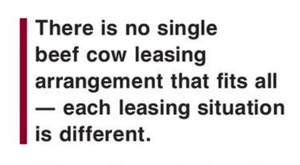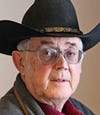Who owns the bulls in a beef cow lease? Who gets the cull cows value? Who owns the replacement heifers? All these questions and more are answered in Harlan's latest blog on fair cow leases.
June 27, 2019

My eastern Wyoming-western Nebraska study herd manager, like many beef producers these days, is growing older and is starting to think about retiring from running his beef cow herd. His management question to me in this month’s meeting was: “What kind of economic returns could I expect from my beef cow herd if I leased the current 250-cow herd to a neighbor?”
Beef cow herd lease
The basic economic concept in leasing a beef cow herd is that the two business parties (the “cow owner” and the “working rancher”) should share calf income in the same proportion as they share production expenses. Sounds pretty logical.
The hard part is projecting the production expenses of each business partner over the production year. The flexible part, and the power of a lease agreement, is that the expense allocations can be tailored to the specific situation of these two specific business partners.
There is no single beef cow leasing arrangement that fits all — each leasing situation is different. Yet, the beef cow industry tends to have one share-lease agreement that it tries to have fit all. This “fit-all” lease frequently is not equitable to one or both business partners.
The only way I know of for determining an equitable beef cow lease is to first create a budget tailored to “that” leased cow herd. In this tailored budget, we first identify all resources consumed by that cow herd over the total lease year. Create your spreadsheet and itemize these resources in the first column.
We then set up a column for the cow owner and a third column for the working rancher. Next, we decide which business partner is going to pay for each production expense, and we put that expense in that appropriate business partner’s column.
We then total the production expenses for the cow owner’s column, and also total the production expenses for the working rancher’s column. If the cow owner pays 30% of the production expenses and the working rancher pays the remaining 70% of the production expenses, then the calf crop is divided 30% to the cow owner and 70% to the working rancher.
I suggested to my study herd manager that a 30-70 beef cow lease would be my general recommendation for a typical situation where one partner owns the cows and other partner provides the feed, grass and labor for the cow herd. This suggests 30% of the calf crop would go to the cow owner, and 70% of the calf crop would go to the working rancher.
I can almost promise that the equitable situation will be different than a 30-70 split. Yes, you need to budget out each unique beef cow lease agreement.
Some basic cow lease rules
There are a few basic rules for participating in a beef cow lease. First, the cow owner gets the cull cow income. The cows are his property. In turn, the cow owner is typically responsible for all replacement heifers, but not in all cases. More on heifer replacement later.
Who owns the bulls in a beef cow lease? Bulls can be owned by either party, or bull ownership can be shared in a beef cow lease. Cull bull income goes to whoever owns the bulls. This is part of the flexibility of a beef cow lease.
Quite often, bull ownership is determined by what the cow owner desires. If the cow owner wants to control the genetics of the beef cow herd through time, he or she may want to own the bulls. In this case, the cost of the bulls (and cull bull income) goes to the cow owner column in the budget.
If the working rancher buys the bulls, the cost of the bulls and the cull bull income goes to the working rancher’s column in the budget.
Who owns the replacement heifers? Quite frequently, older cow owners want to get out of the cow business slowly, over a few years. Thus, the cow owner has no interest in investing back in replacement heifers and maybe not even replacement bulls.
 In this case, the working rancher can put the replacement heifers back into the herd as well as the replacement bulls. These replacement females and their calves are not part of the leased herd and are accounted for in a separate herd owned and operated by the working rancher.
In this case, the working rancher can put the replacement heifers back into the herd as well as the replacement bulls. These replacement females and their calves are not part of the leased herd and are accounted for in a separate herd owned and operated by the working rancher.
As the cow owner’s cows are culled from the herd each year — let’s say over seven to eight years — all of the cow owner’s cows will be sold as culls. This is a nice way for the cow owner to spread the sale of those cows over those seven to eight years.
If the working rancher annually keeps the replacement heifers over this period, he or she will eventually own the complete cow herd. A cow lease arrangement can be an ideal way for a young rancher, with limited investment capital, to eventually gain ownership of a beef cow herd.
Beef cow lease problems
There are a few business rules that need to be considered in a beef cow lease. First, beef cow leases need to be set up to run for a year, from weaning to weaning.
Take my word for it, problems typically occur when the lease starts and ends at any other time of the year. Expense allocation becomes a nightmare! These businesses frequently get terminated via a lawyer, and that is not good.
The second problem is bred heifer replacements. It is best if heifers are developed by a third party — or at a minimum, under a separate business contract.
The reason for potential problems here is that heifer production costs can NOT be allocated by the same percentages as the running of a cow herd. It will not work!
Yet, I find this kind of heifer replacement arrangements out there, and one business partner is typically very unhappy. Again, it works best if heifers are developed by a third party.
Now, after this discussion, my study herd manager now wants to see a specific budget for his cow herd leased to a neighbor. This will be the subject of my next article. Stay tuned.
Hughes is a North Dakota State University professor emeritus. He lives in Kuna, Idaho. Reach him at 701-238-9607 or [email protected].
About the Author(s)
You May Also Like





